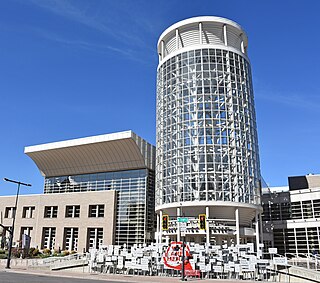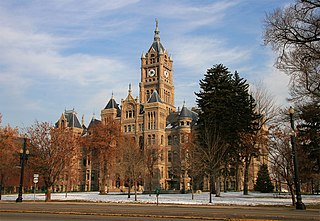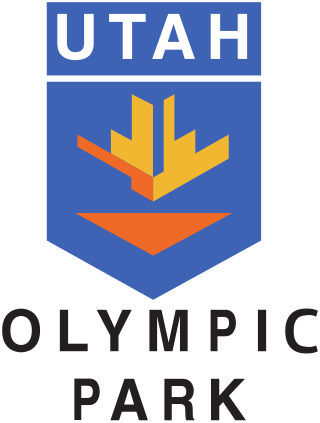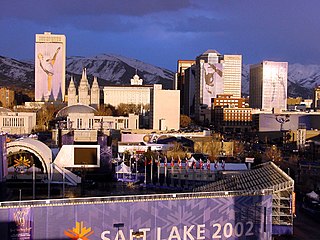
Salt Lake City, often shortened to Salt Lake or SLC, is the capital and most populous city of the U.S. state of Utah. It is the seat of Salt Lake County, the most populous county in the state. The city is the core of the Salt Lake City Metropolitan Statistical Area (MSA), which had a population of 1,257,936 at the 2020 census. Salt Lake City is further situated within a larger metropolis known as the Salt Lake City–Ogden–Provo Combined Statistical Area, a corridor of contiguous urban and suburban development stretched along a 120-mile (190 km) segment of the Wasatch Front, comprising a population of 2,746,164, making it the 22nd largest in the nation. With a population of 200,133 in 2020, it is the 117th most populous city in the United States. It is also the central core of the larger of only two major urban areas located within the Great Basin.

Parowan is a city in and the county seat of Iron County, Utah, United States. The population was 2,790 at the 2010 census, and in 2018 the estimated population was 3,100.

Pioneer Day is an official holiday celebrated on July 24 in the U.S. state of Utah, with some celebrations taking place in regions of surrounding states originally settled by Mormon pioneers. It commemorates the entry of Brigham Young and the first group of Mormon pioneers into the Salt Lake Valley on July 24, 1847, where the Latter-day Saints settled after being forced from Nauvoo, Illinois, and other locations in the eastern United States. Parades, fireworks, rodeos, and other festivities help commemorate the event. Similar to July 4, many local and all state-run government offices and many businesses are closed on Pioneer Day.

Temple Square is a 10-acre (4.0 ha) complex, owned by the Church of Jesus Christ of Latter-day Saints, in the center of Salt Lake City, Utah. The usage of the name has gradually changed to include several other church facilities that are immediately adjacent to Temple Square. Contained within Temple Square are the Salt Lake Temple, Salt Lake Tabernacle, Salt Lake Assembly Hall, the Seagull Monument, and two visitors' centers. The square was designated a National Historic Landmark District in 1964, recognizing the Mormon achievement in the settlement of Utah.

The Calvin L. Rampton Salt Palace Convention Center, more commonly known as the Salt Palace, is a convention center in Salt Lake City, Utah. Named after Utah's 11th governor, Calvin L. Rampton, the moniker "Salt Palace" was previously used by two other venues in the city.

Salt Lake City, Utah has many historic and notable sites within its immediate borders. Although the entire Salt Lake City metropolitan area is often referred to as "Salt Lake City", this article is concerned only with the buildings and sites within the official city limits of Salt Lake City.

The Salt Lake City and County Building, usually called the "City-County Building", is the seat of government for Salt Lake City, Utah. The historic landmark formerly housed offices for Salt Lake County government as well, hence the name.

Downtown is the oldest district in Salt Lake City, Utah, United States. The grid from which the entire city is laid out originates at Temple Square, the location of the Salt Lake Temple.

Martin's Cove is a historic site in Wyoming. The 933 acre (3.8 km2) cove is located 55 miles (89 km) southwest of Casper, Wyoming, in Natrona County. It is located on the Mormon Trail and is also part of the North Platte-Sweetwater segment of the Oregon Trail. The Cove was listed in the National Register of Historic Places on March 8, 1977.

Soldier Hollow is a cross-country ski venue located at the mouth of a hollow of the same name about 53 miles (85 km) southeast of Salt Lake City in Wasatch Mountain State Park in northwestern Wasatch County, Utah, United States. The venue was created for the 2002 Winter Olympics and it hosted the biathlon, cross-country skiing, and the cross country skiing portion of the Nordic combined events, a role it is expected reprise for the 2034 Winter Olympics.

The Utah Territorial Statehouse, officially Territorial Statehouse State Park Museum, is a state park in Fillmore, Utah. The museum and park preserves the original seat of government for Utah Territory before the capital was moved to Salt Lake City in 1856. Built from 1852 to 1855, the statehouse was initially intended as a larger structure, but only the south wing was completed before the project was abandoned due to lack of federal funding. After its construction, the Utah Territorial Legislative Assembly met in the building for only one full session and parts of two others.
Peaks Ice Arena is an indoor ice hockey and figure skating arena in Provo, Utah, located 43 miles (69 km) south of Salt Lake City. Along with the Maverik Center in West Valley City, it was built as an ice hockey and figure skating practice venue for the 2002 Winter Olympics. It currently serves as the home of the Utah Valley University men’s ice hockey team, Peaks Youth Hockey Association, several high school teams, the Peaks Figure Skating Club, and a Learn-to-Skate USA program for beginning skaters of all ages.

The International Society Daughters of Utah Pioneers is a women's organization dedicated to preserving the history of the original settlers of the geographic area covered by the State of Deseret and Utah Territory, including Mormon pioneers. The organization is open to any woman who is: (1) A direct-line descendant or legally adopted direct-line descendant with a pioneer ancestor; (2) the pioneer ancestor is a person who traveled to or through the geographic area covered by the State of Deseret/Utah Territory between July 1847 and 10 May 1869 ; (3) over the age of eighteen, and of good character. Travel through the geographic area covered by the State of Deseret/Utah Territory can be either east to west, west to east, north to south, or south to north.

The Utah Olympic Oval is an indoor speed skating oval located 14 miles (23 km) southwest of Salt Lake City, in Kearns, Utah. The Oval was built for the 2002 Winter Olympics and it hosted the long-track speed skating events for the 2002 games, a role it is expected reprise for the 2034 Winter Olympics.

City Creek Center (CCC), commonly shortened to City Creek, is a mixed-use development containing an upscale open-air shopping mall, grocery store, and office and residential buildings near Temple Square in downtown Salt Lake City, Utah, United States. Opened on March 22, 2012, the development encompasses over 23 acres (9.3 ha) across portions of three city blocks. The center's mall includes a foliage-lined walkway with a simulated stream, meant to recreate City Creek, an important water source for the early settlers of Salt Lake City.

The Utah Olympic Park is a winter sports park built for the 2002 Winter Olympics, and is located in Summit County northwest of Park City, Utah, United States. During the 2002 games the park hosted the bobsleigh, skeleton, luge, ski jumping, and Nordic combined events. It still serves a training center for Olympic and development level athletes.

Ensign Peak is a dome-shaped peak in the hills just north of downtown Salt Lake City, Utah. The peak and surrounding area are part of Ensign Peak Nature Park, which is owned by the city. The hill's summit is accessed via a popular hiking trail, and provides an elevated view of Salt Lake Valley and Great Salt Lake.
The Ice Sheet at Ogden, also known as the Weber County Ice Sheet, is located 35 miles (56 km) north of Salt Lake City on the campus of Weber State University in Ogden. The Ice Sheet opened in 1994 as a recreational training center for curling, ice hockey, and figure skating. During the 2002 Winter Olympics the Ice Sheet hosted curling events, a role it is expected reprise during the 2034 Winter Olympics. The Ice Sheet is also home to the Ogden Mustangs, a junior ice hockey team in the United States Premier Hockey League and Weber State University's men's hockey team.

The 2002 Winter Olympic Games were held in and around Salt Lake City, United States from February 8 to 24, 2002, and the Paralympics from March 7 to 16, 2002. The sporting events were held in ten competitive venues, while non-competitive events, such as the opening ceremony, were held in six other venues. Three venues were also created for training purposes. All Olympic venues were scattered throughout Northern Utah and the Wasatch Front.

The Mormon Trail Center at Winter Quarters is a museum and visitors' center of the Church of Jesus Christ of Latter-day Saints located in the Florence neighborhood of Omaha, Nebraska, United States. The museum interprets the story of the Mormon Trail along with the history of a temporary Mormon settlement known as Winter Quarters, which was located in the Florence area between 1846–1848.






















